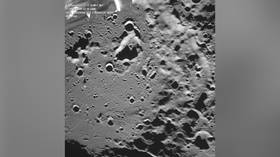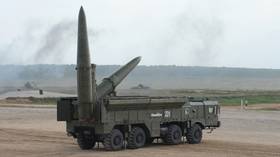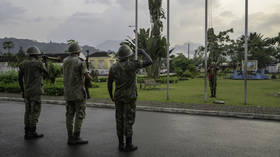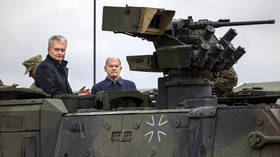NASA shares alleged images of Russian Moon-lander crash site (PHOTOS)
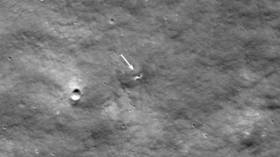
NASA has published images purporting to show the impact site of Russia’s Luna 25 Moon mission, which crashed on the lunar surface last month due to a suspected technical glitch, according to Moscow’s space agency.
First published on Thursday, the photos were captured last week by imaging systems on board NASA’s Lunar Reconnaissance Orbiter (LRO), a robotic craft stationed in the Moon’s orbit capable of high-resolution photos.
Using data shared by Russia’s space agency, Roscosmos, the NASA team located the likely impact point along the inner rim of the Pontecoulant G crater and made comparisons to previous photos of the area. The researchers discovered what appears to be an impact crater about 10 meters wide, believing it to be the final resting place for the Luna 25 probe.
“Since this new crater is close to the Luna-25 estimated impact point, the LRO team concludes it is likely to be from that mission, rather than a natural impactor,” NASA officials said.
#NASA has released a Set of Images showing the Crash Site of the Luna-25 #Moon Lander of the #Russian Space Corporation, Roscosmos which Crashed on the South Pole of the Moon after an Engine Failure on August 19th. 🇷🇺 pic.twitter.com/f2V7J8E3vi
— Global Defense Insight (@Defense_Talks) September 1, 2023
The Russian craft failed to touch down in late August following an engine issue, according to Roscosmos, which has since announced an investigation into the incident.
“Unfortunately, the engine shutdown did not happen normally, in accordance with the sequence diagram, but based on a time stamp, and instead of the planned 84 seconds, it ran for 127 seconds,” Roscosmos head Yury Borisov said.
However, Borisov noted that Roscosmos engineers received valuable experience while building Luna-25, despite the failure of the mission. He said the team behind the project “will, of course, take into account all the mistakes that were made during this mission,” and went on to express hope for “the future missions of Luna-26, 27, and 28.”
Luna-25 aimed to land near the lunar south pole, which is known for its rugged terrain. All previous lander missions to the Moon by various nations touched down in the equatorial regions.
The Russian spacecraft successfully reached lunar orbit, sending back high-resolution photos of the Moon. The mission was scheduled to attempt to land on August 21.
